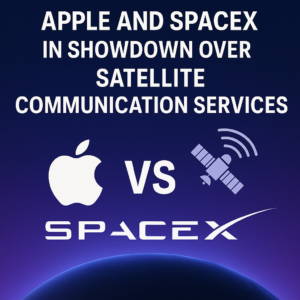
Apple vs. SpaceX: The Battle for Satellite Connectivity Dominance
In a high-stakes race to dominate the next frontier of mobile connectivity, two tech titans—Apple and SpaceX—are vying for control of the skies. The competition centers on satellite-based communication services that promise to eliminate cellphone dead zones by beaming signals from space directly to devices on Earth.
Both companies have invested heavily in satellite technology, but their competing visions and approaches are now sparking regulatory tensions and drawing attention from wireless carriers, hardware manufacturers, and global users alike.
🚀 The Tech Behind the Battle
At the heart of this rivalry is direct-to-device satellite communication, a technology that allows smartphones to send and receive messages without relying on traditional ground-based cell towers. This has the potential to revolutionize global communication—especially in rural, mountainous, or disaster-prone areas where conventional infrastructure is unreliable or nonexistent.
• SpaceX, through its Starlink satellite constellation, has partnered with T-Mobile to offer satellite-to-phone capabilities, promising limited data and messaging support even without a cellular signal.
• Apple, on the other hand, introduced Emergency SOS via Satellite with the iPhone 14 and expanded it further in later models. This feature uses a specialized modem and backend partnership with Globalstar to provide critical emergency connectivity.
While Apple’s implementation is currently limited to emergencies, its ambitions suggest a broader rollout of consumer-facing satellite services may be on the horizon.
⚖️ The Regulatory Dispute
The growing conflict between Apple and SpaceX is not just technical—it’s regulatory. Both companies are competing for access to limited radio spectrum, which is essential for satellite communication. This competition has drawn the attention of the Federal Communications Commission (FCC) in the United States, along with international spectrum regulators.
According to reports from the Wall Street Journal, Apple has filed objections to SpaceX’s requests for spectrum expansion, arguing that interference could degrade its own satellite services. Meanwhile, SpaceX has pushed for regulatory approval to allow more flexible use of its Starlink constellation for direct-to-device communication.
Despite the friction, the FCC has granted certain permissions to both sides, including allowing T-Mobile and SpaceX’s partnership to support limited iPhone functionality in dead zones.
📱 What This Means for iPhone Users
For now, the direct impact on iPhone users is limited to Apple’s Emergency SOS via Satellite, which has already proven useful in real-world rescue situations. However, if Apple expands into full-fledged satellite messaging or voice service, it could rival traditional carriers in rural markets and transform how we think about cellular coverage.
Meanwhile, SpaceX’s approach aims to work with a broader array of carriers and devices, potentially opening satellite access to Android phones and lower-cost hardware via its T-Mobile deal.
The competition could ultimately benefit users, resulting in:
• More reliable mobile coverage globally
• Faster rollout of emergency communication features
• New hybrid satellite-cellular data plans
🧠 The Bigger Picture
This clash isn’t just about connectivity—it’s a strategic battle for control over the next generation of communication infrastructure. With both companies at the cutting edge of innovation, the outcome will shape not only consumer experience but also industry standards, government regulations, and global data networks.
📌 Final Thoughts
Apple and SpaceX’s rivalry over satellite communication services highlights the growing convergence of consumer tech and aerospace innovation. As both companies push forward, users can expect broader connectivity, smarter devices, and new ways to stay connected—even when far off the grid.
The sky, it seems, is no longer the limit—it’s the battleground.
